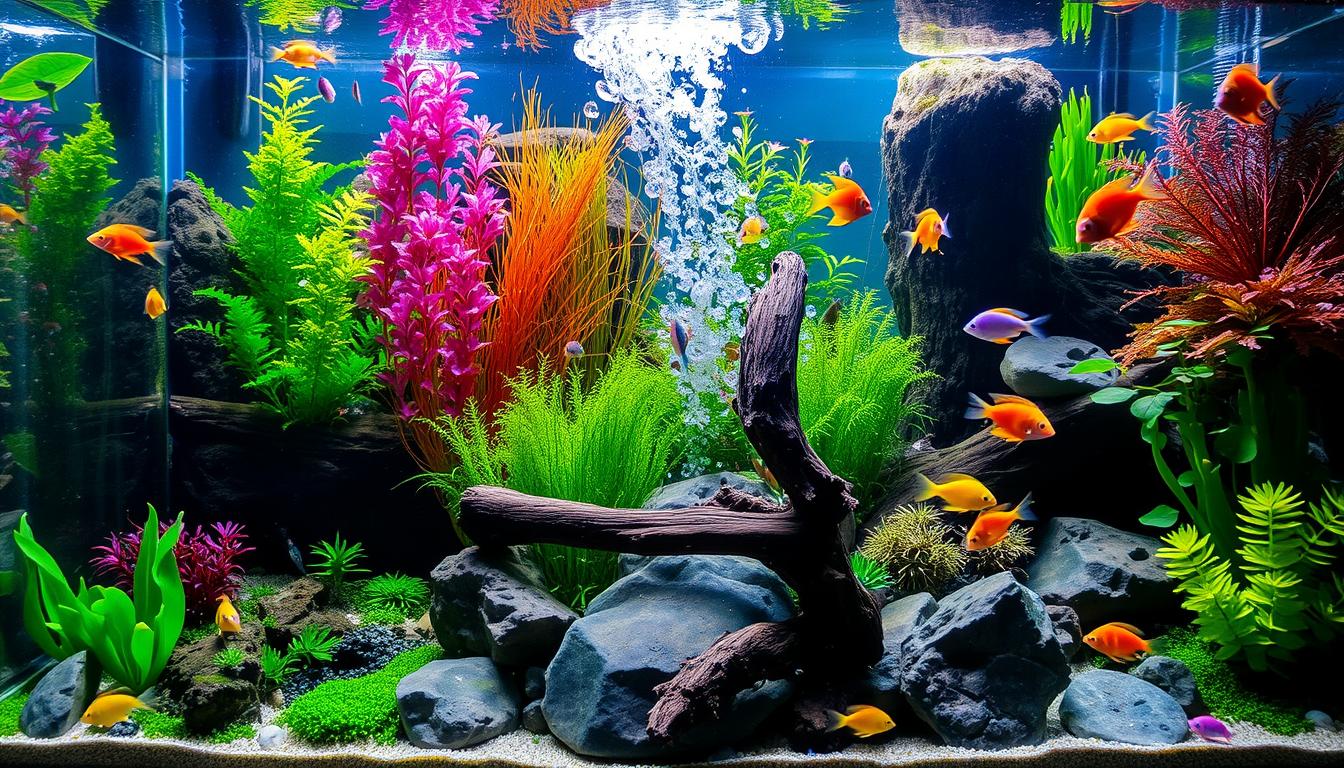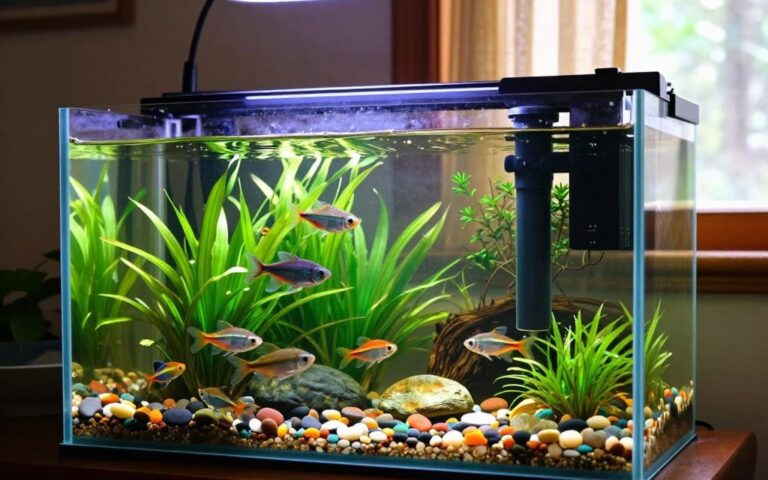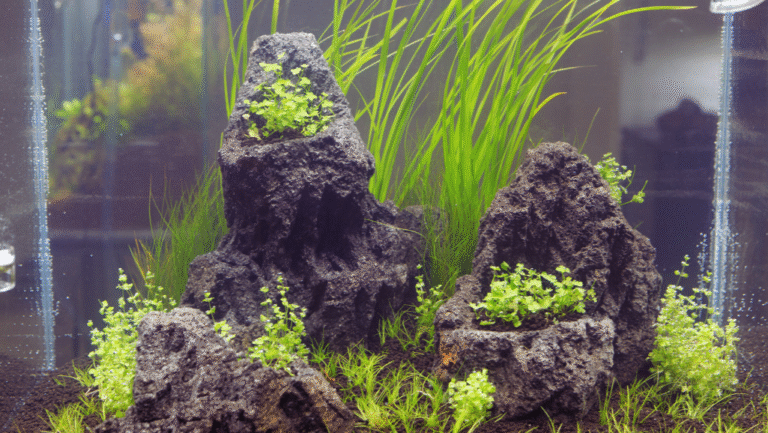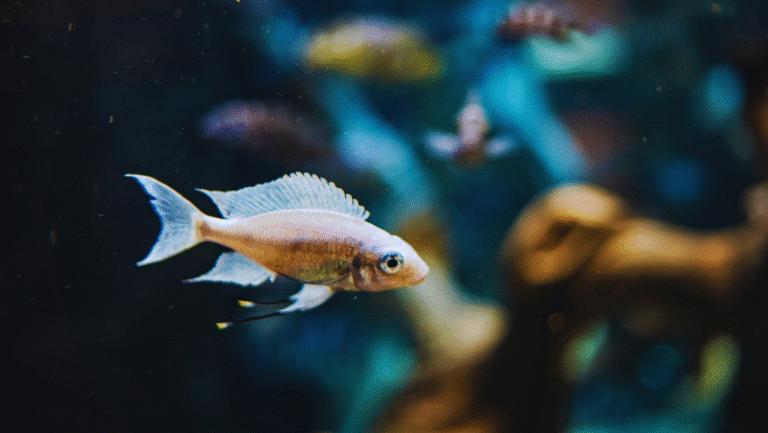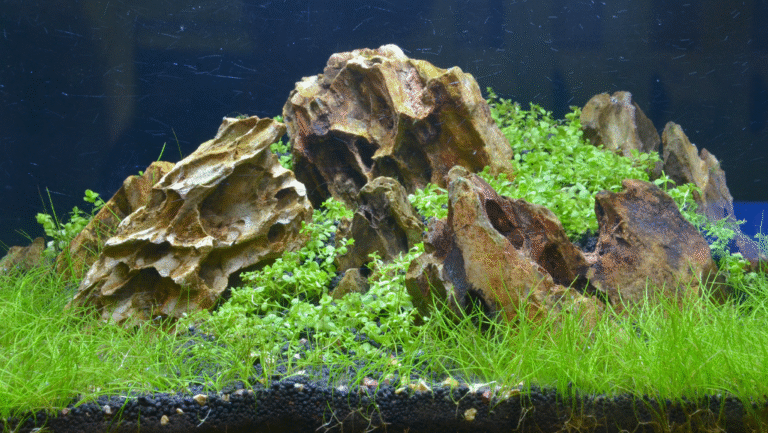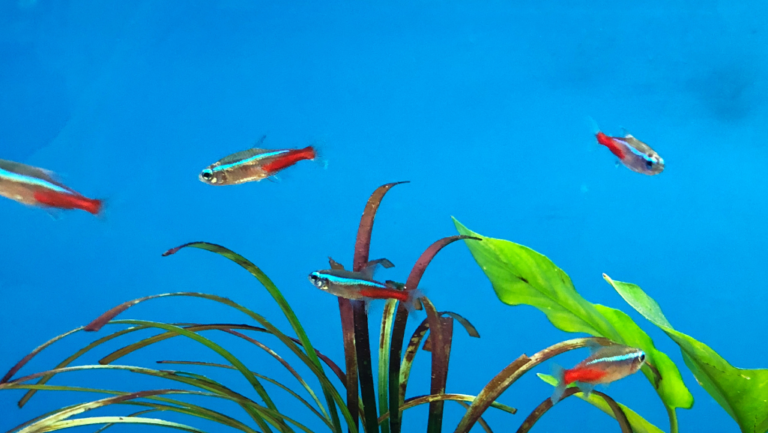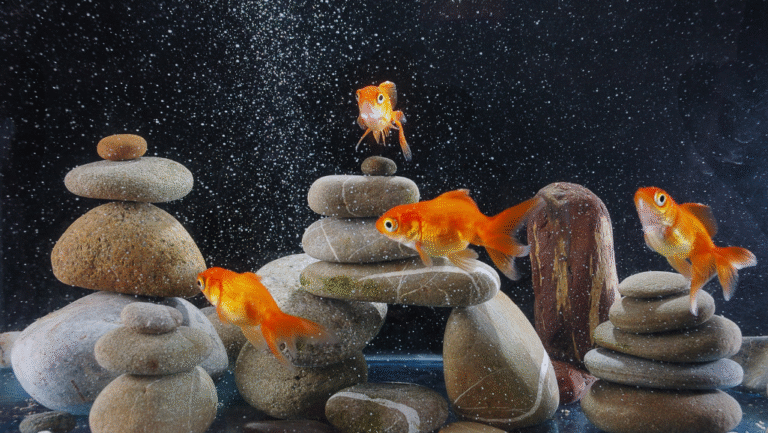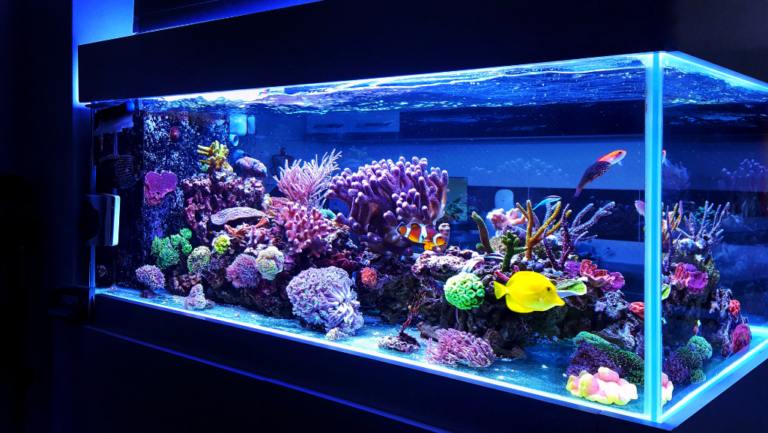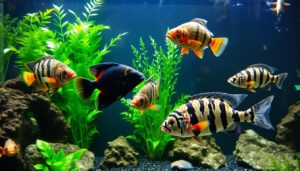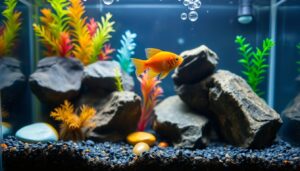Dive into the world of aquarium basics and start an amazing aquatic adventure. Setting up your first fish tank is thrilling. It brings a magical underwater world into your home. Learning the basics of aquarium care is crucial for success.
Choosing the right tank size is important. You might pick a small 5-gallon tank or a big 45-gallon one. But remember, a 45-gallon tank can weigh over 360 pounds when full. So, pick a good spot for it.
To start, you’ll need a water filter kit, heater, and aquarium light. Also, get a water conditioner, fish gravel, and some decor. Adding plants can make your tank look great and keep the water clean.
Key Takeaways
- Aquariums range from 5 to 45 gallons, catering to various space requirements
- Essential equipment includes filters, heaters, lights, and water conditioners
- Allow 48 hours for water balance before introducing fish
- Choose tank size and location carefully, considering weight factors
- Aquatic plants can improve both appearance and water quality
Introduction to the Fascinating World of Aquariums
Aquariums bring the beauty of underwater worlds into our homes. They create miniatures full of life, color, and movement. Let’s start with the basics of aquarium keeping and see the joy it brings.
What is an aquarium?
An aquarium is a special container that holds water and life inside. It looks like a real underwater place, home to fish, plants, and other sea creatures. You can find aquariums in many sizes, from tiny ones for your desk to big ones for your room.
Benefits of keeping an aquarium
Having an aquarium has many benefits. It can make you feel less stressed, improve your mood, and make your space look unique. It also teaches you about taking care of things and caring for the environment. Watching fish can even help lower your blood pressure and make you sleep better.
Types of aquariums
There are different kinds of aquariums you can have. Freshwater aquariums are great for beginners and have fish like guppies and tetras. Saltwater aquariums take you to the ocean, with colorful fish and corals. Planted aquariums focus on plants, making an underwater garden.
| Aquarium Type | Difficulty Level | Suitable For |
|---|---|---|
| Freshwater | Beginner | Tropical fish, easy-care plants |
| Saltwater | Advanced | Marine fish, corals, invertebrates |
| Planted | Intermediate | Aquatic plants, small fish |
For beginners, a 20 to 30-gallon freshwater aquarium is perfect. It’s big enough for many fish and easy to take care of. Remember, starting an aquarium takes time. The process of making it ready for fish takes about 4-6 weeks to make sure it’s safe for them.
Choosing the Right Aquarium for Your Space
Choosing the right aquarium means thinking about size, location, and space needs. Your choice affects your home’s look and your fish’s health.
A filled aquarium weighs about 10-12 pounds per gallon. Add 1.5-2 pounds per gallon for gravel. Make sure your spot can handle this weight.
Where you put your tank is key. Choose a spot out of direct sunlight and heat to keep water stable. Most tropical fish like water between 75° and 80° F.
For equipment like filters and heaters, you’ll need outlets nearby.
Space needs depend on the aquarium type. Freshwater setups are great for beginners because they’re easier to maintain. Popular fish for beginners include:
- Guppies
- Tetras
- Betta fish
- Corydoras catfish
- Zebra Danios
If you’re moving to saltwater, think about Clownfish, Damselfish, Gobies, or Blennies. The type of aquarium you choose affects both space and care needs.
Essential Equipment for Your Underwater Ecosystem
Creating a thriving aquarium needs the right equipment. Let’s look at the key parts you need for a healthy home for your fish.
Filtration Systems
Filtration systems keep the water clean. Choose a filter that cycles the water 3-5 times an hour for your tank size. For a 20-gallon tank, pick a filter rated at 60-100 gallons per hour. External filters are great for big tanks, and internal filters are better for smaller ones.
Heaters and Thermometers
Aquarium heaters keep the water at a stable temperature. Aim for 3-5 watts per gallon of water. Always use a thermometer to check the temperature doesn’t change too much.
Lighting Options
Good lighting makes fish colors pop and helps plants grow. For fish-only tanks, use 1-2 watts of light per gallon. A 30-watt, 36″ fluorescent light is perfect for 15-30 gallon tanks. High-tech planted tanks need more intense lighting with high PAR values.
Air Pumps and Decorations
Air pumps add oxygen and create movement in the water. Decorations like gravel and plants give fish places to hide. Use 1-2 inches of substrate, with 1-2 pounds per gallon. Remember, decorations can take up to 10% of the water volume.
| Equipment | Recommendation |
|---|---|
| Filter | 3-5x water volume per hour |
| Heater | 3-5 watts per gallon |
| Lighting | 1-2 watts per gallon (fish-only) |
| Substrate | 1-2 lbs per gallon |
Understanding Water Chemistry and Parameters
Keeping the right water balance is key for a healthy aquarium. Important factors include pH levels, ammonia, nitrite, nitrate, and water hardness. Testing the water often helps keep a stable home for your fish.
pH levels show how acidic or alkaline the water is. Fish do best in certain pH ranges, based on where they live in nature. Don’t change the pH too much each day to keep your fish stress-free. Carbonate hardness (KH) helps keep the pH steady by acting as a buffer against sudden changes.
Ammonia and nitrite are very bad for fish. Just a little bit can make their gills inflamed and cause them to gasp for air. Nitrate isn’t as bad but can slow down fish growth and breeding if it gets too high. Changing the water often helps keep these bad stuff in check.
Water hardness is important too. It’s made up of general hardness (GH) and carbonate hardness (KH). GH is about minerals like calcium and magnesium. Different fish like different hardness levels. KH is about carbonates and bicarbonates, which help keep the pH stable.
| Parameter | Ideal Range | Effects |
|---|---|---|
| Ammonia | 0 ppm | Toxic, causes gill damage |
| Nitrite | 0 ppm | Affects oxygen transport |
| Nitrate | <20 ppm | Impacts growth and breeding |
| pH | 6.5-7.5 | Varies by species |
| GH | 4-8 dGH | Affects osmoregulation |
Testing and adjusting these water parameters often will make a great home for your fish.
Aquarium Basics: Setting Up Your Tank
Setting up your aquarium is an exciting step in creating your underwater world. A well-planned tank preparation ensures a healthy environment for your aquatic friends.
Preparing the Tank
Begin by cleaning the tank thoroughly. Use warm water and skip the soap, as it can harm fish. Rinse the tank well to remove any residue.
Place the tank in its final spot, making sure it’s level and sturdy. This is important for the tank’s safety and balance.
Adding Substrate and Decorations
When picking substrate for a 20-gallon tank, get about 30-40 pounds of gravel or sand. Rinse it well before adding it to the tank. This step is crucial for cleanliness.
For decorations, think about looks and usefulness. Use rocks, driftwood, and artificial caves for fish to hide in. Put bigger items in the back, leaving an open area in front for swimming.
Filling the Tank and Treating Water
Fill the tank with water that’s free of chlorine. To avoid stirring up the substrate, pour water onto a clean plate in the tank. This method helps keep your setup neat.
Make sure the water is at 78°F for the fish’s health. Use a heater and thermometer to keep an eye on the temperature. Also, set up a good filtration system that can clean the water 3-5 times an hour.
- Clean tank thoroughly
- Add 1.5-2 pounds of substrate per gallon
- Arrange decorations for aesthetics and functionality
- Fill with treated water
- Install and set up equipment
After these steps, your tank is ready for the cycling process. This prepares it for a healthy home for your fish.
Cycling Your Aquarium: The Crucial First Step
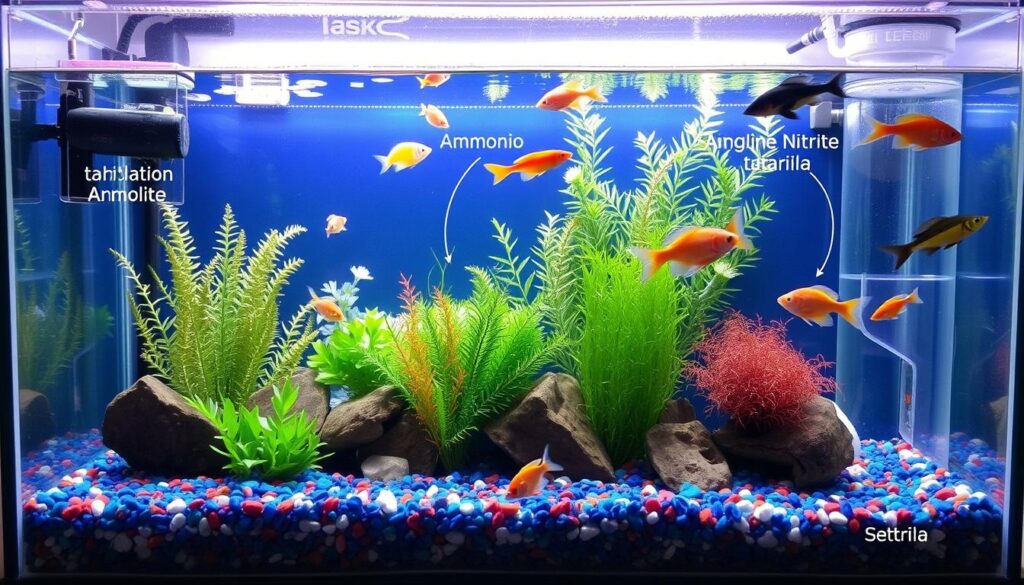
Aquarium cycling is key to creating a healthy home for your fish. It helps grow beneficial bacteria to handle waste. These bacteria turn harmful ammonia into safer nitrite and then nitrate.
This process takes about four to eight weeks. It’s important to watch the water closely during this time. Keep the pH between 7.0 and 7.8 and the temperature at 83°F to 87°F to help bacteria grow.
Testing the water often is a must. Check for ammonia, nitrite, and nitrate every one to two days. If ammonia levels go above 5 ppm, change 10-20% of the water with treated water.
| Parameter | Acceptable Range | Testing Frequency |
|---|---|---|
| Ammonia | 0-5 ppm | Every 1-2 days |
| Nitrite | 0 ppm (end goal) | Every 1-2 days |
| Nitrate | Detectable (end of cycle) | Every 1-2 days |
There are two ways to cycle your aquarium: fishless and fish-in. Fishless cycling is kinder but takes longer. Add fish food to keep ammonia levels high. Fish-in cycling adds up to three hardy fish but is tricky for beginners.
Your aquarium is ready when there’s no ammonia or nitrite and nitrates are present. This process lays the groundwork for a healthy aquatic world.
Selecting Fish for Your Aquarium
Choosing the right fish for your aquarium is key to a healthy underwater world. Think about tank size, water conditions, and how well fish get along. Let’s look at some popular choices and what to keep in mind.
Popular Beginner-Friendly Fish Species
For those new to aquariums, some fish are easier to care for. Here are some easy-to-start fish:
- Guppies
- Tetras
- Bettas
- Corydoras catfish
These fish are tough and fit well in different water settings. For saltwater fans, try clownfish, damselfish, and gobies as starters.
Compatibility Considerations
Getting along with other fish is important for a calm aquarium. Look at size, behavior, and living needs when choosing fish. Schooling fish like neon tetras do best in groups of six or more. Don’t mix aggressive with peaceful fish.
Stocking Levels and Guidelines
Right stocking is key for fish health. Here are some tips:
- Add fish slowly over weeks
- Don’t put too many fish in to keep water clean
- Think about the adult size of fish when planning
Some fish need a lot of space. For example, goldfish should have 20 to 50 gallons per fish because they’re big and produce a lot of waste.
| Fish Type | Minimum Tank Size | Group Size |
|---|---|---|
| Guppies | 10 gallons | 3-5 |
| Neon Tetras | 20 gallons | 6+ |
| Bettas | 5 gallons | 1 (male) |
| Goldfish | 20-50 gallons | 1-2 |
By thinking about these things, you’ll make a great home for your fish.
Introducing Live Plants to Your Aquatic Environment
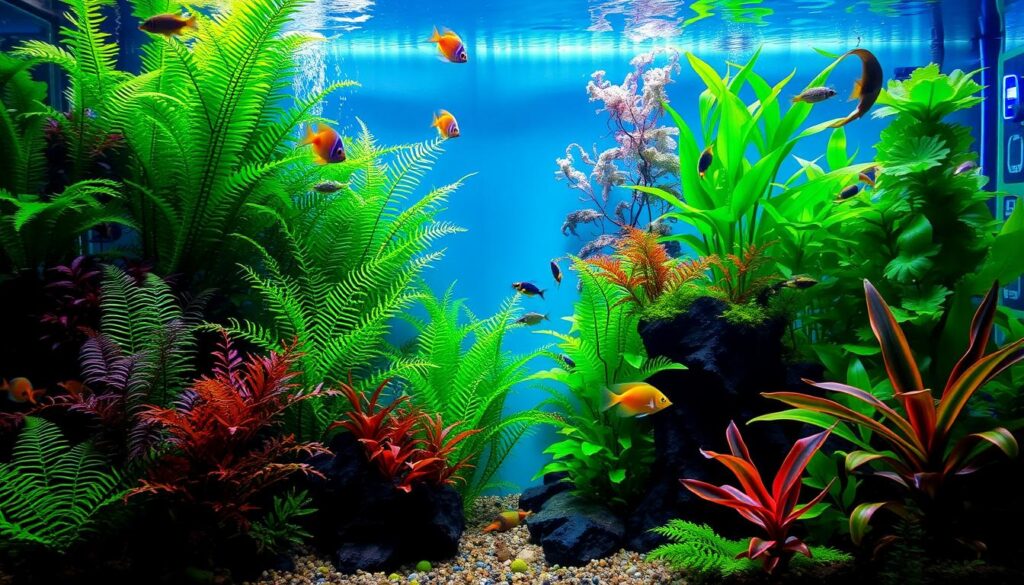
Adding live plants to your aquarium turns it into a lively underwater garden. These plants help keep the water clean by taking in carbon dioxide and ammonia from fish. They also make your tank look beautiful and provide a safe place for fish to hide.
When picking plants, think about how much light they need and how fast they grow. Great choices for beginners include Java fern, Anubias, and Amazon sword. These plants are easy to take care of and fit well in many tank settings.
Good lighting is key for plants to thrive. LED lights are long-lasting and don’t get hot, helping plants grow well. You should have 8 to 10 hours of light on your tank every day. Aim for 2 to 5 watts of light per gallon for the best results.
Fertilizers are important for keeping your plants healthy. You can use different types like substrate, tablet, or liquid fertilizers. Liquid fertilizers are good for weekly feeding, especially for plants that take in nutrients through their leaves.
- Improve water quality
- Provide shelter for fish
- Enhance natural appearance
- Contribute to biological filtration
Wait 2 to 3 weeks before adding fish to your planted tank. This lets the plants and the ecosystem settle. Make sure to check the pH levels and water hardness. Use products like Seachem Acid Buffer and Neutral Regulator to keep everything balanced.
| Plant Type | Light Requirement | Growth Rate | Difficulty |
|---|---|---|---|
| Java Fern | Low to Medium | Slow | Easy |
| Anubias | Low to Medium | Slow | Easy |
| Amazon Sword | Medium to High | Moderate | Moderate |
| Cryptocoryne | Low to Medium | Slow | Easy |
Feeding Your Fish: Proper Nutrition and Schedules
Feeding your fish the right food and at the right time is key to a healthy aquarium. Many people overfeed their fish, which can cause big problems. It’s important to feed them just the right amount to keep them happy and healthy.
Adult fish usually need food once a day. Younger fish might need to eat more often. Always give them only what they can eat in about five minutes. This stops too much food from making the water dirty and harming your fish.
Each fish species has its own food needs. Herbivores might eat more often than carnivores. For fish that are most active at night, feed them in the evening. Start by giving your fish 1% of their body weight in food every day.
For good nutrition, use a mix of fish foods. This can be flakes, pellets, freeze-dried foods, and frozen treats. Change the feeding schedule based on your fish’s size, type, and how active they are.
| Fish Type | Feeding Frequency | Food Amount |
|---|---|---|
| Adult Fish | Once daily | Consumed in 5 minutes |
| Young Fish | 2-3 times daily | Small portions |
| Herbivores | More frequent | Plant-based diet |
| Carnivores | Less frequent | Protein-rich diet |
Don’t overfeed your fish, as it’s a common mistake. It’s safer to feed them a little less than too much. Fish can go without food for up to two weeks, so don’t worry if you forget a day. By following these tips, you’ll feed your fish right and keep their home clean and healthy.
Regular Maintenance and Care Routines

Keeping your aquarium in top shape is key for a lively underwater world. Regular care keeps your fish happy and your tank sparkling. Let’s explore the must-do routines for a stunning aquatic scene.
Water Changes and Cleaning
Changing the water is a big part of aquarium care. It’s advised to change 25% of your tank’s water every two weeks. This step removes harmful waste and adds back important minerals. Don’t forget to use a gravel vacuum to clean the tank’s bottom, getting rid of any leftover food or debris.
Filter Maintenance
Filters are crucial for a clean aquarium. Clean the mechanical filter media, like foam, in tank water every month to keep the good bacteria. Change chemical media every 4-6 weeks as needed. Biological media usually doesn’t need replacing unless it’s damaged. A well-kept filter means good water flow and quality.
Monitoring Fish Health
Watch your fish closely for any signs of stress or sickness. Look out for changes in eating habits, odd swimming, or visible health issues. Catching problems early is key. Keep the water temperature steady between 74-82°F (23-28°C) for your fish’s health.
- Test water weekly with API MASTER TEST KITS or API 5-IN-1 TEST STRIPS
- Add API QUICK START to boost beneficial bacteria during tank maintenance
- Use API STRESS COAT to treat tap water for changes
- Apply API STRESS ZYME weekly to improve water quality
Stick to these aquarium care routines for a thriving underwater home for your fish. Remember, being consistent is crucial in fish keeping!
Troubleshooting Common Aquarium Issues
Aquarium problems can happen even with good care. Keeping an eye on water quality is key for fish owners. It’s important to test the water often for things like pH, ammonia, nitrite, and nitrate levels.
Changing a bit of the water every week helps keep it clean. Replace about 20% of the water to stop waste from building up.
Dealing with algae is a big challenge. Too much light or too many nutrients can cause green water. To fix this, cut back on the light and don’t overfeed your fish.
Brown algae is normal in new tanks but can be kept under control. Clean your tank regularly and add fish that eat algae.
Fish diseases are a big worry. Always keep new fish in a separate tank before adding them to your main one. This helps stop diseases from spreading. Look out for signs like fish gasping at the surface, which might mean chlorine got in the water. Use a conditioner to remove chlorine from the water.
- Test water parameters weekly
- Change 20% of water monthly once established
- Quarantine new fish to prevent disease spread
- Use water conditioner to remove chlorine
Feeding your fish too much is a common mistake. Only give them what they can eat in one to five minutes, once a day. This keeps the water clean and stops bacteria from growing. A stable environment is crucial for a healthy aquarium.
Conclusion
Starting the aquarium hobby brings a world of wonder into your home. By 1999, 9.6 million U.S. households had an aquarium. This shows how many people love fish keeping. Today, Americans look after 139 million freshwater and 9.6 million saltwater fish.
Creating a healthy aquarium takes careful planning. A 55-gallon tank is great for beginners. For those just starting, a 20 or 25-gallon tank is a good choice. It’s important to know that fish get 80% of their oxygen from the water.
Successful fish keeping is about more than just water. You need proper filters, regular care, and the right fish types. Adding live plants can make your aquarium look beautiful and stay healthy. They need a CO2 level of 20-25 mg per liter. As you learn more, you’ll find joy in caring for your underwater world.
